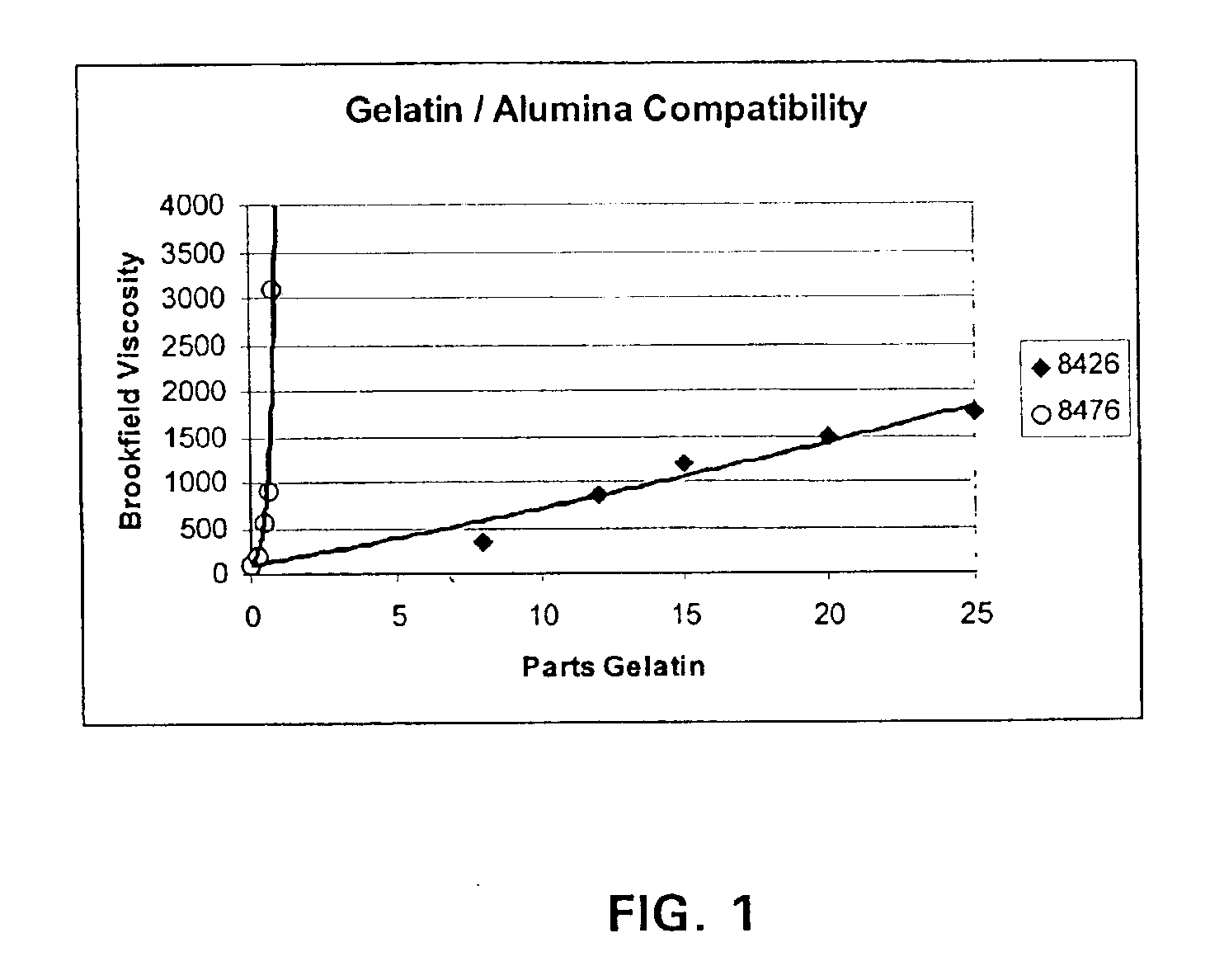Microporous photo glossy inkjet recording media
a technology of inkjet printing and microporous photo, which is applied in the field of inkjet printing media, can solve the problems of limited compatibility between gelatin and alumina hydrate, affecting the quality of inkjet printing, so as to improve the specular gloss, smoothness and distinctness of image, and minimize the reduction of porosity of topcoat. the effect of the reduction
- Summary
- Abstract
- Description
- Claims
- Application Information
AI Technical Summary
Benefits of technology
Problems solved by technology
Method used
Image
Examples
example 1
Gloss Promoting Basecoat A
[0036]Example 1 illustrates the composition of a basecoat formulation according to the invention as follows:
[0037]
Alcoa Hydralcoat2 (alumina tri-hydrate)54.5parts dryGrace-Davison W-300 (silica)36.4parts dryRohm&Haas BC-643 (binder coated9.1parts dryhollow-sphere plastic pigment)Alco Alcosperse 149P (dispersant)0.9parts as receivedRohm&Haas NW1845K (acrylic polymer)8.2parts dryClariant Cartacoat LP (PEG)6.8parts drySolvox Special 647 (defoamer)as needed
The solids content of this coating is 50%, with a stable Brookfield viscosity (100 rpm, spindle 5, at 86 degrees F.) of about 650 cp.
[0038]The ink-receptive topcoat layer primarily comprises alumina hydrate, gelatin, and a water-insoluble cationic polymer. Alumina hydrate-provides high surface area and porosity combined with cationic surface sites, making it particularly well-suited for solvent / carrier fluid absorption and dye fixation. The term alumina hydrate, as used herein, includes any of a variety of cr...
example 2
[0058]Example 2 illustrates the composition of an ink-receptive coating formulation according to the invention as follows:
[0059]
Sasol 14N4-80 (Alumina hydrate)100parts dryKind & Knox 8426 (ULMW hydrolyzed4parts drygelatin)Interpolymer HX31-654parts dry(water-insoluble cationic polymer)BASF K-17 (PVP)1part dryRhodia Igepal CA 897 (surfactant)1part dryNalco 99PG028 (defoamer)as needed
The solids content of this coating is 42%, with a stable Brookfield viscosity (100 rpm, spindle 5, 86 degrees F.) of about 700 cp.
[0060]As a further example, the absorbent basecoat formulation of Example 1 and the ink-receptive coating formulation of Example 2 may be employed together to construct a printing medium comprising a substrate, a basecoat layer according to Example 1 and an ink-receptive topcoat layer according to Example 2. In a variation of this example, the printing medium has a two-layer construction comprising the substrate, the basecoat layer directly coated onto at least one side of the ...
example 3
Matte Printable Basecoat B
[0070]Example 3 illustrates the composition of a basecoat suitable for the gloss-over-matte embodiment, according to the inventive matte-finish, inkjet printable coating formulation described above. The solids content of this coating is 37% with a stable Brookfield (100 rpm, spindle 5) viscosity of about 1200 cp.
[0071]
Alcoa Hydralcoat7 (alumina tri-hydrate)19.5partsGrace Davison W300 (silica gel)42.5partsSMI Jetcoat 30 (specialty PCC)38partsClariant Mowiol 23-88 (PVOH)4partsCargil 39D (starch)2partsAir Products 426 (vinyl acetate-ethylene,8partsVAE)BASF Luviscol K-17 (PVP)2partsNalco Nalkat 2020 (polyDADMAC)2partsNalco FM 1223 (defoamer)as needed
[0072]Application of 9 g / m2 Basecoat B, followed by a topcoat of 10 g / m2 with the microporous ink-receptive coating described in Example 2, gives equal inkjet print quality compared to samples made with 18 g / m2 Basecoat A, followed by 10 g / m2 of topcoat. However, the 60- and 75-degree glosses are reduced by approxim...
PUM
| Property | Measurement | Unit |
|---|---|---|
| Fraction | aaaaa | aaaaa |
| Fraction | aaaaa | aaaaa |
| Fraction | aaaaa | aaaaa |
Abstract
Description
Claims
Application Information
 Login to View More
Login to View More - R&D
- Intellectual Property
- Life Sciences
- Materials
- Tech Scout
- Unparalleled Data Quality
- Higher Quality Content
- 60% Fewer Hallucinations
Browse by: Latest US Patents, China's latest patents, Technical Efficacy Thesaurus, Application Domain, Technology Topic, Popular Technical Reports.
© 2025 PatSnap. All rights reserved.Legal|Privacy policy|Modern Slavery Act Transparency Statement|Sitemap|About US| Contact US: help@patsnap.com

